STORE AUCTIONS ALL SPECIMENS ON SALE MINERALS ACCESSORIES BOOKSTORE RULES REGISTER LOGIN ABOUT US CONTACT US MAILING
SPECIMENS
now available:
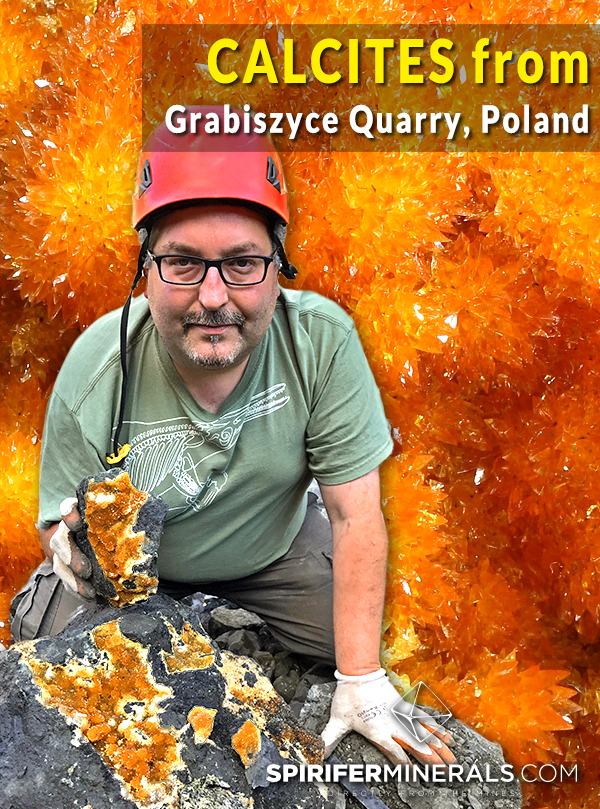
Calcites from Grabiszyce Quarry, Leśna,
Lower Silesia, Poland
by Tomasz Praszkier
INTRODUCTION and HISTORY
Thanks to the efforts of local collectors from the Lubań area in SW Poland, in 2015 the new occurrence of attractive calcites was discovered in the Grabiszyce Basalt quarry. Two zones producing two distinctive types of calcites were identified. For two years, while keeping quiet about the discovery, the quarry was visited almost every Sunday to collect specimens. Finally, in the begging of 2018 we decided to reveal the discovery to the public. This short note is the first publication about the find in English, a detailed article was published in MINERALIEN WELT (issue 2018/01 - more details here). In the future we are also planning to print a booklet dedicated to Grabiszyce calcites.
LOCATION
Grabiszyce Basalt Quarry is located between the town of Leśna and the village of Grabiszyce, in Western Sudetes, SW Poland. The quarry is about 250 m long, with 3 main levels of exploitation.
Grabiszyce is an active mine and permission to visit is strictly required.
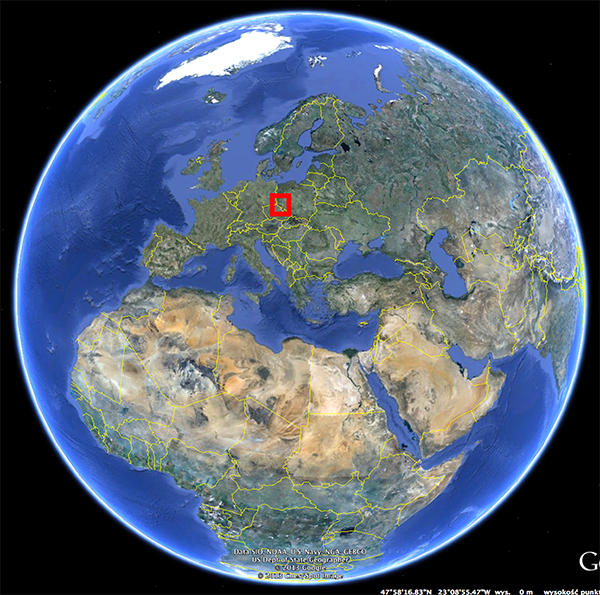
Satellite photo of Earth with marked area that is shown in the next figure.
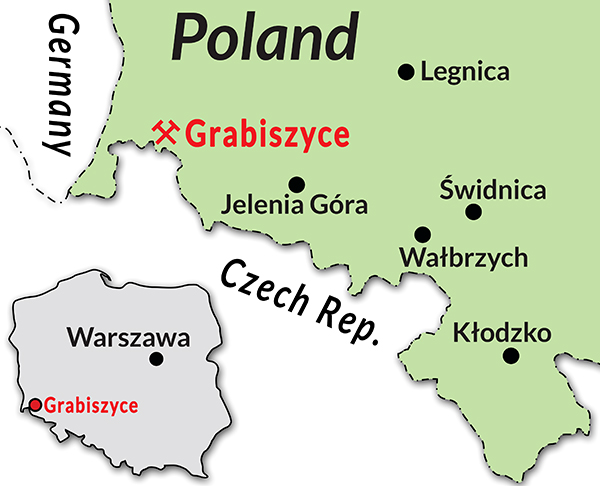
Map of Poland with Grabiszyce area marked, and close-up of south-western Poland.

Map of the quarry vicinity; yellow line marks the borderline with the Czech Republik.
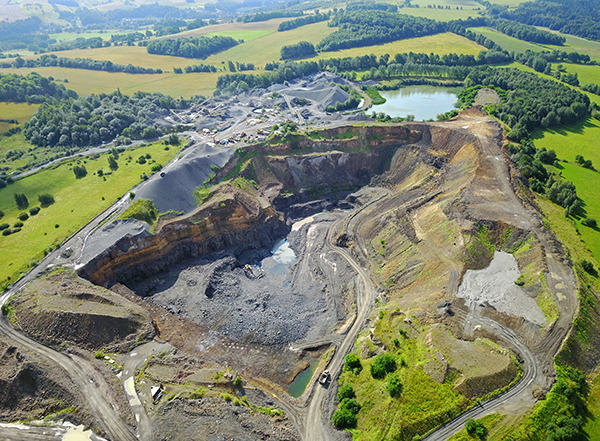
Aerial view to the quarry. T. Praszkier photo.
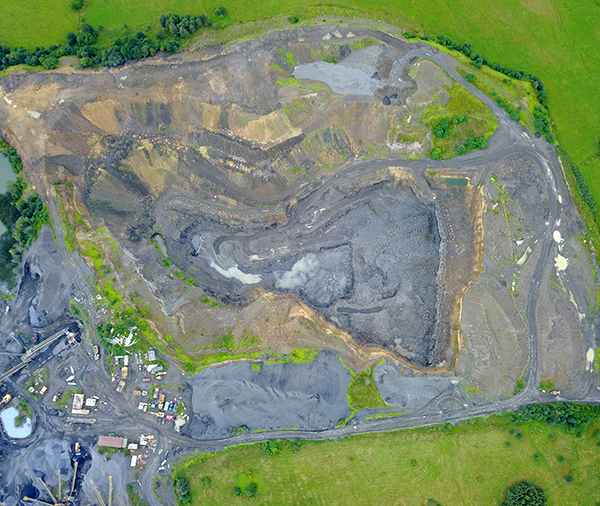
Aerial view to the quarry. T. Praszkier photo.

Aerial view to the quarry. T. Praszkier photo.
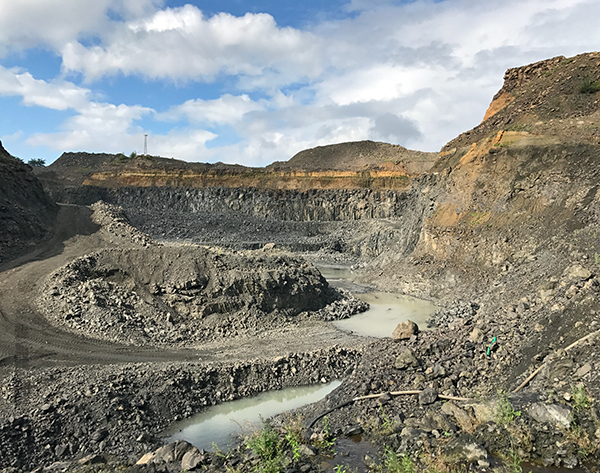
Grabiszyce Quarry. J. Praszkier photo.
Drone footage of the quarry and its surroundings. J. & T. Praszkier movie.
GEOLOGY and SPECIMENS
The Grabiszyce quarry is located in the Karkonosze-lzera Block geological unite, which is a part of the Sudetes Mts. Alkaline basalts mined in the quarry are part of a bigger volcanic province spread around Lubań. They were exploited from the XIII century for the construction purposes.
Internal structure of the basalt flows is diversified due to different conditions of cooling. The central parts of the bodies are usually formed as typical pillars, and peripheral parts are much more irregular. Due to lava contact with underlying rocks and presence of water vapor under a high pressure, basalts can be highly decomposed. Some bodies were also hydrothermally changed as an effect of later effusive episodes.
In the Grabiszyce quarry two overlapping lava flows are exposed. They are dated as 28-30 Mya – Oligocenian (Paleogene) and separated by a thin complex of sedimentary rocks. A volcanic neck known as “Stożek Perkuna”, located only 750 m from the quarry, is interpreted as a source of the lava flows.
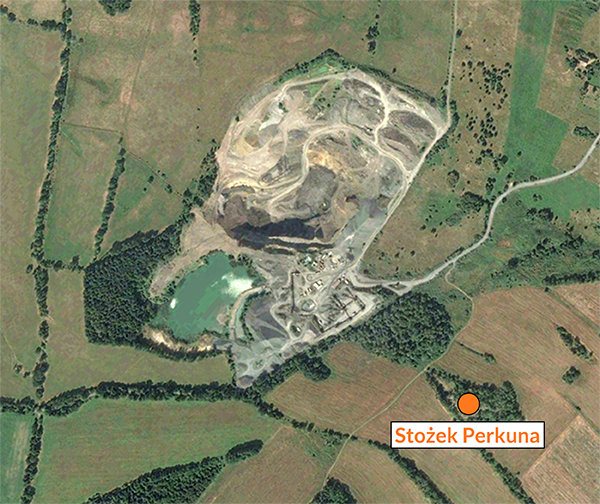
Sattelite photo of the quarry with the volcanic neck called "Stożek Perkuna" marked.
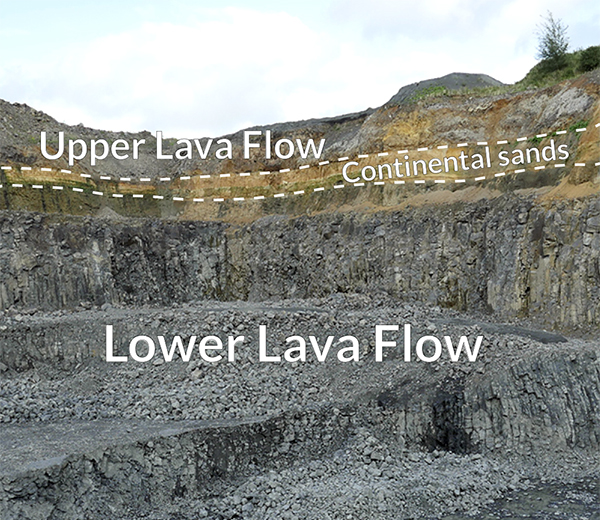
Two lava flows interbedded by continental sands visible in the quarry. J. Praszkier photo.
Calcite mineralization is present in the quarry in two different areas – both in the lower lava flow, but in different zones of it. Both of them are very different and distinctive.
The zone that is the most productive for specimens was formed in the peripheral part of the basalt flow, and now is located on SW side of the quarry. This zone is only a few meters long and about 1 m wide and dips almost vertically. In general it is a breccia built by fragments of basalt, with many open spaces between them. Walls of the pockets are overgrown by yellow-orange drusy calcite. Most of the pockets are only a few cm across, but some reach up to 30 cm. Their shape is very irregular. Basalt in this area is highly altered and decomposed, and many of the pockets fall apart during extraction. The breccia zone is already (begging of 2017) almost completely extracted, its remains pinch down and soon will be mined out.

Collecting in the breccia zone. J. Praszkier photo.

Breccia zone rich in calcite mineralization. J. Praszkier photo.
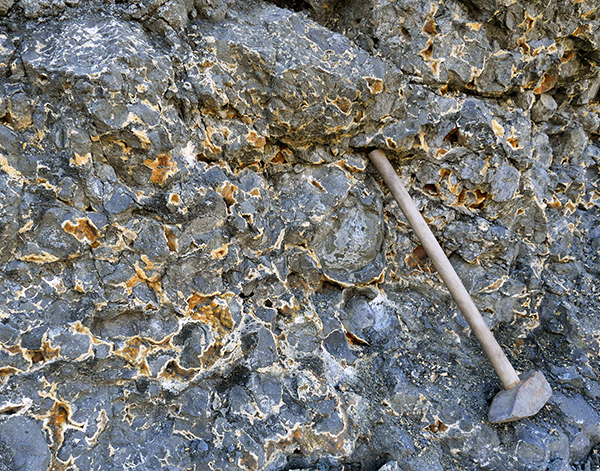
Breccia zone rich in calcite mineralization. J. Praszkier photo.
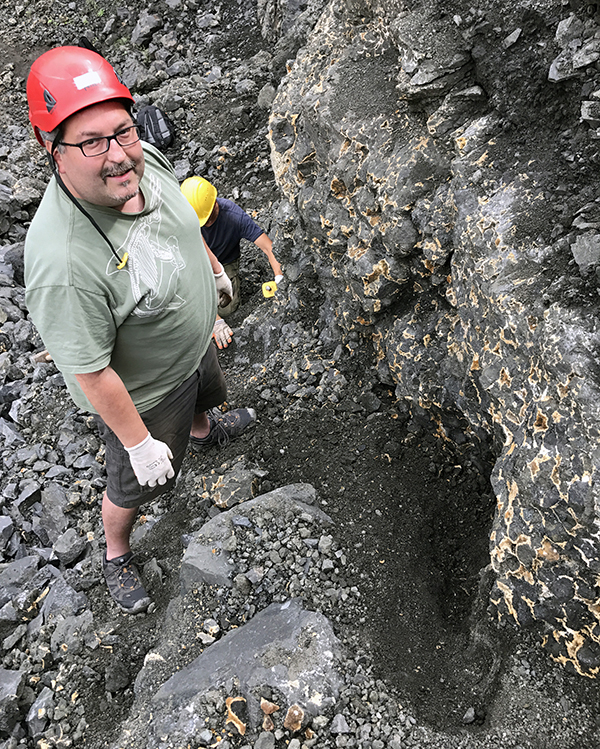
Tom in front of the breccia zone. J. Praszkier photo.
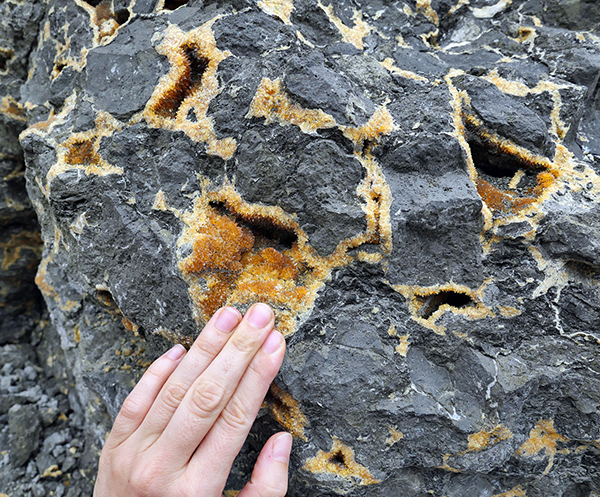
Numerous calcite pockets in the breccia zone. J. Praszkier photo.
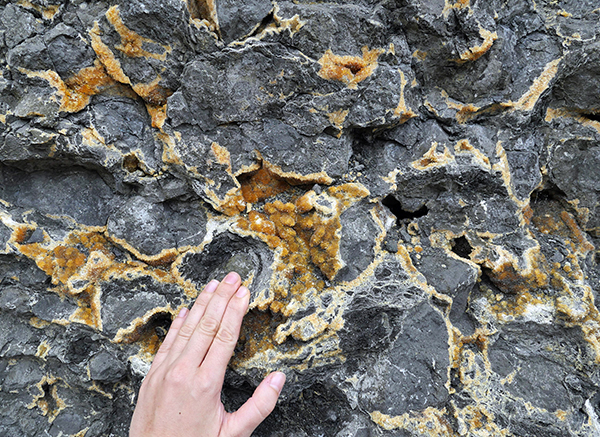
Numerous calcite pockets in the breccia zone. J. Praszkier photo.
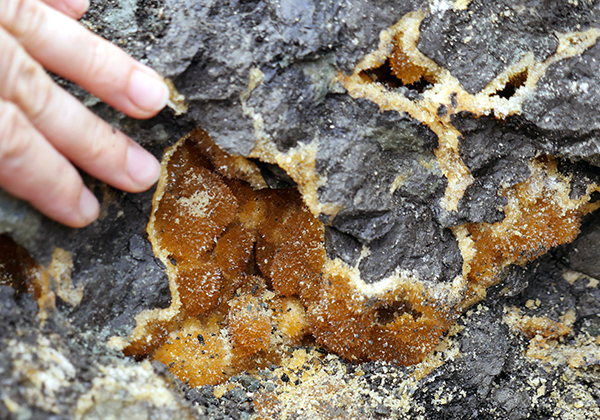
Freshly opened calcite pocket. J. Praszkier photo.
Specimens from the breccia zone were generally extracted in smaller sizes because the basalt there was partly decomposed and easily split into smaller fragments. Specimens from better pockets were collected as fragments as big as possible, and trimmed later. After preparation the majority of the specimens became relatively small, usually between 3-10 cm. There was only a dozen of specimens above 15 cm. The most attractive, intensively orange clusters were quite rare. Most of the specimens are flat, only small percentage has rosettes of crystals or other interesting shapes. Luster on most of the specimens is good. Looking on general quality only a few dozens of specimens, from hundreds, is good quality.
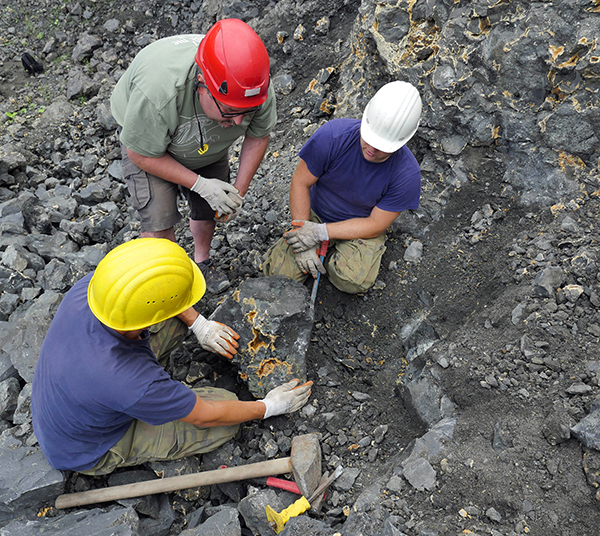
Collecting in the breccia zone. J. Praszkier photo.
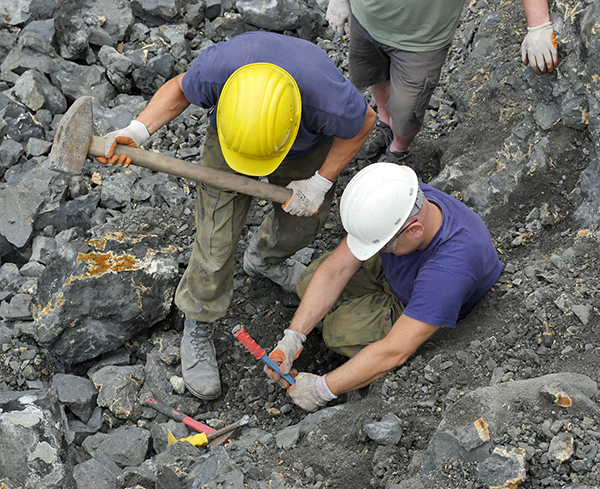
Collecting in the breccia zone. J. Praszkier photo.
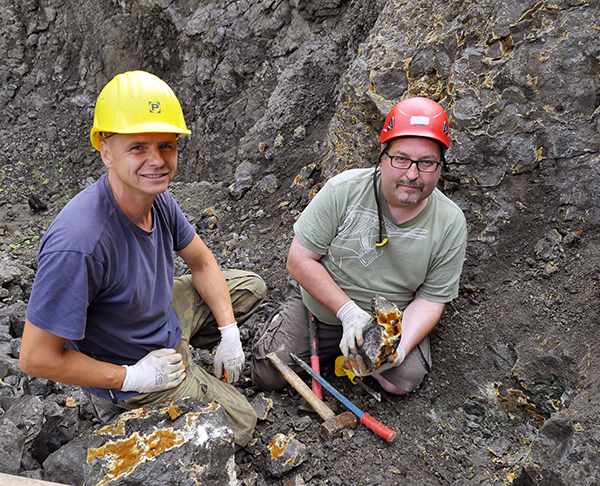
Collecting in the breccia zone. J. Praszkier photo.

Collecting in the breccia zone. J. Praszkier photo.

Collecting in the breccia zone. J. Praszkier photo.

Collecting in the breccia zone. J. Praszkier photo.
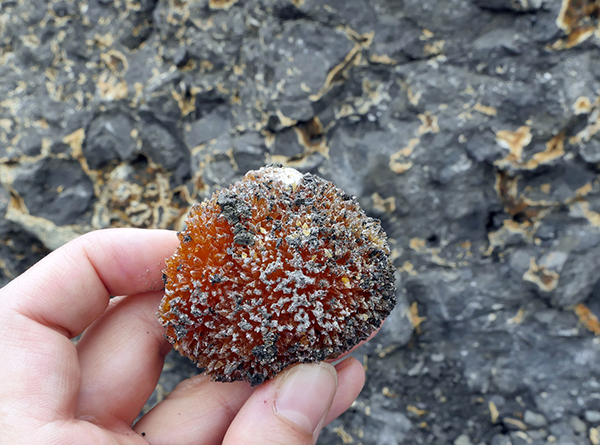
Freshly collected calcite specimen. J. Praszkier photo.
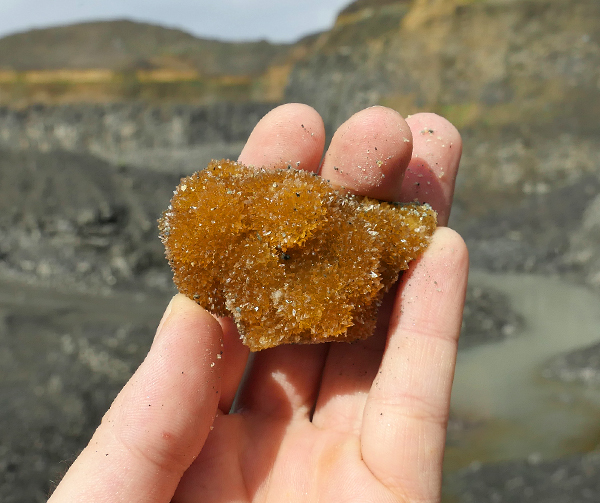
Freshly collected calcite specimen. J. Praszkier photo.

This is how the specimens look like before the preparation, they need a lot of trimming. T. Praszkier photo.

This is how the specimens look like before the preparation, they need a lot of trimming. T. Praszkier photo.

Calcites from the breccia zone after cleaning and trimming. Spirifer specimens. J. Praszkier photo.

Calcite specimen from the breccia zone, size 10 cm. Spirifer specimen. J. Praszkier photo.

Rosettes of deep orange calcite from the breccia zone, size 8 cm. Spirifer specimen. J. Praszkier photo.

Rosettes of deep orange calcite from the breccia zone, size 9 cm. Spirifer specimen. J. Praszkier photo.
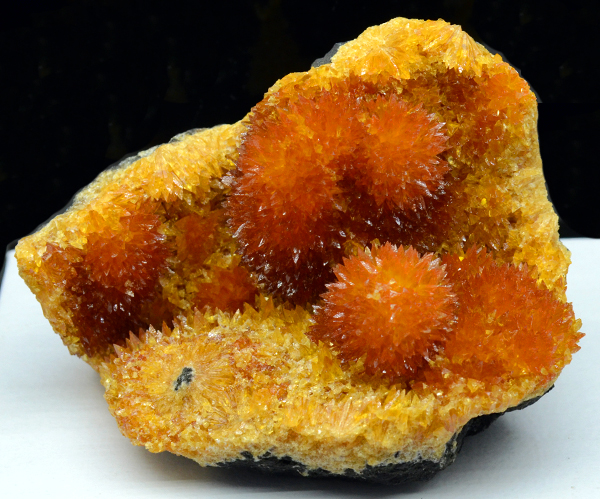
Rosettes of deep orange calcite from the breccia zone, size 9 cm. Spirifer collection. J. Praszkier photo.
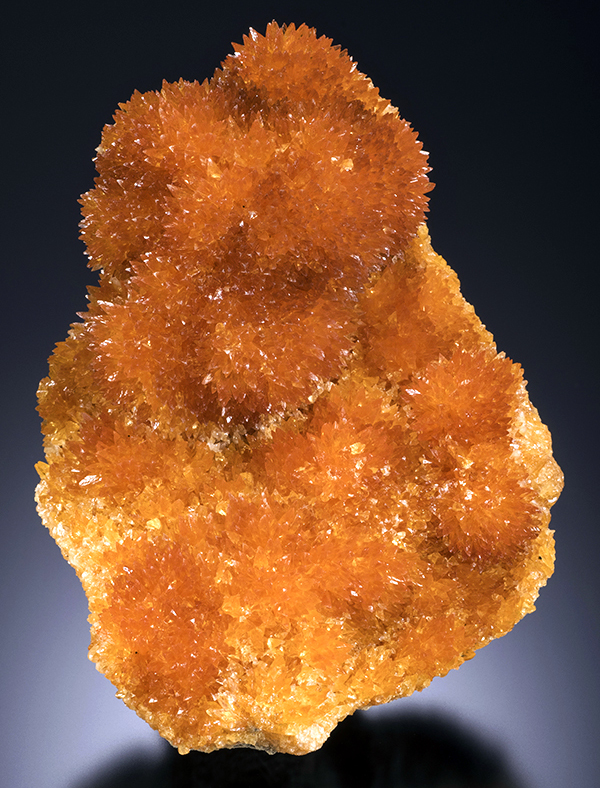
Intensively orange calcite, size 10 cm. M. Oleszczuk specimen. J. Scovil photo.
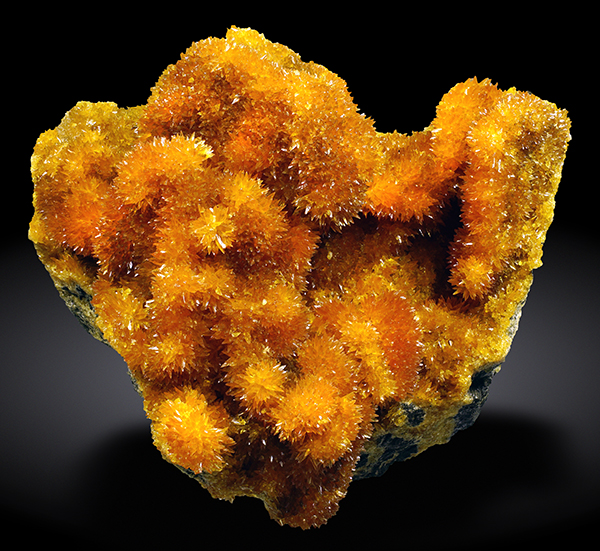
Calcite specimen with interesting morphology, size 14 cm. Spirifer collection. J. Callen photo.
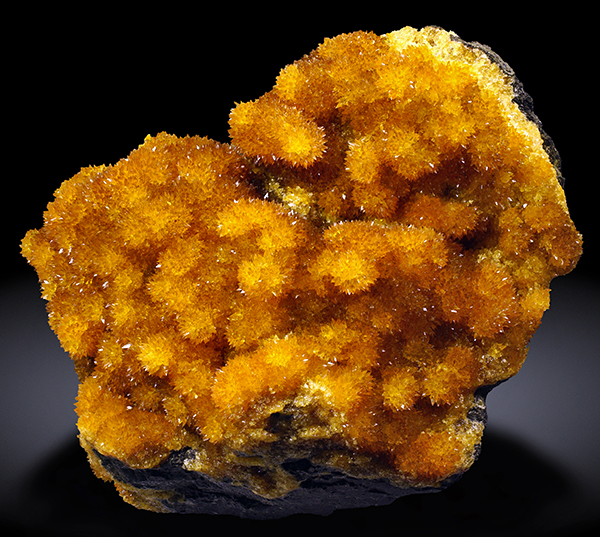
Calcite, size 10 cm. Spirifer collection. J. Callen photo.
The second zone producing calcite specimens is located on the main wall of the quarry, on its W side. The lower part of the quarry wall consists of well-developed pillars, and the uppermost part is a more massive basalt with irregular joints – and this is the part which produces calcite specimens. They occur in very narrow cavities formed as thermal contraction joints. They are distributed irregularly, their size varies from a few cm to over a meter, but their thickness is very rarely more than 3-4 cm. This is the reason why majority of the calcites are contacted on both sides of the cavities and break during extraction. Between some cavities there are big differences in morphology of the crystals.
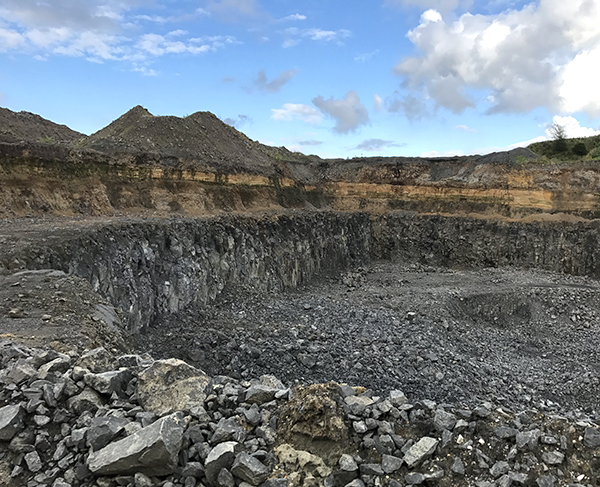
The second productive zone is located in the upper part of the main quarry level, on the top of the lower lava flow. J. Praszkier photo.
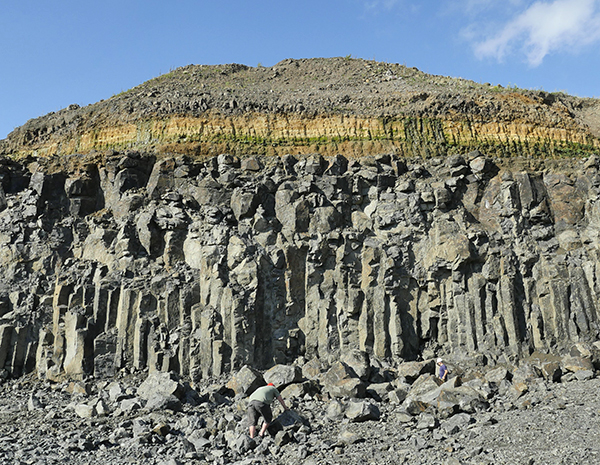
The second productive zone is located above the basalt pillars, in the upper part of the quarry level. J. Praszkier photo.
In contrast to breccia zone, calcites from that zone, occur in extremely solid basalt, on huge blocks. These blocks fall down from the quarry wall after blasting. The size of them reaches up to 2 m. When calcite is present on them, and luckily survives the 10 m fall off the quarry wall, then the only option for extraction is to cut the rock with a big saw. Due to the amount of effort and time needed to do that only the best pieces have been extracted, lower quality went to the crusher. In general calcite in this zone is much less abundant than in the breccia zone, furthermore the number of pieces which survived the fall becomes even lower after the extraction process. Moreover, calcite occurs in narrow cracks, so spheres are rarely without contacts. In the two year period only about 50 specimens have been collected from this zone. The majority of them are 5-15 cm, usually with some contacts and small areas of damage. From about 50 specimens extracted from that zone only less than 10 are really high quality, and almost each of them is a little bit different in terms of crystallization, associated species and color of the matrix. Crystallography is diverse – from sharp crystals to hemispheroidal shapes. Also associated minerals are more diversified – most of the calcites are on black basalt but some are on botryoidal grey, blue or even iridescent coating of the ferrosaponite. Additionally, some calcites are associated with a few mm big phillipsite crystals what makes specimens more sparkly. The best specimen is about 15 cm big with 5 spheroids of calcite with rhombohedral faces sticking out from them.
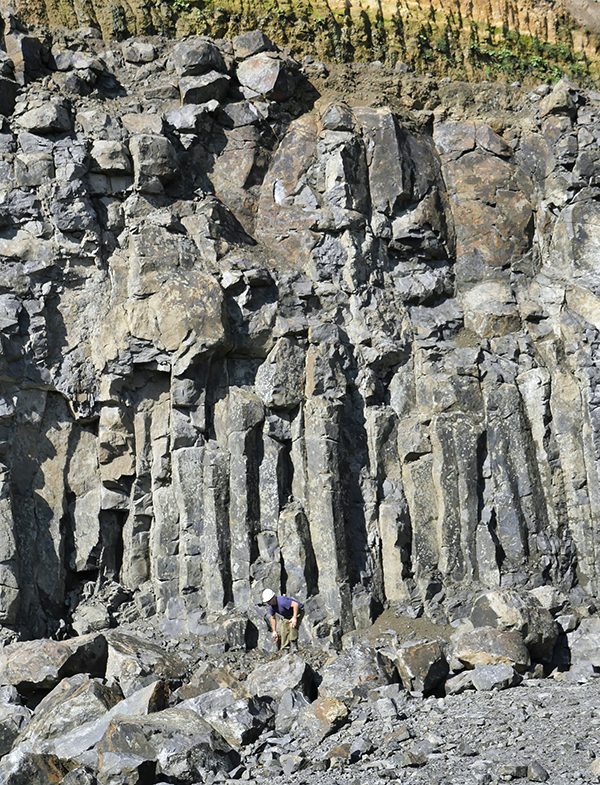
Collecting specimens from the second productive zone. They are found there as big basalt blocks that have fallen down from the top of the wall. Their original source is located above the basalt pillars. J. Praszkier photo.

The only way to extract calcites from the big blocks of massive basalt is to cut them off with a diamond saw. P. Lejczak photo.
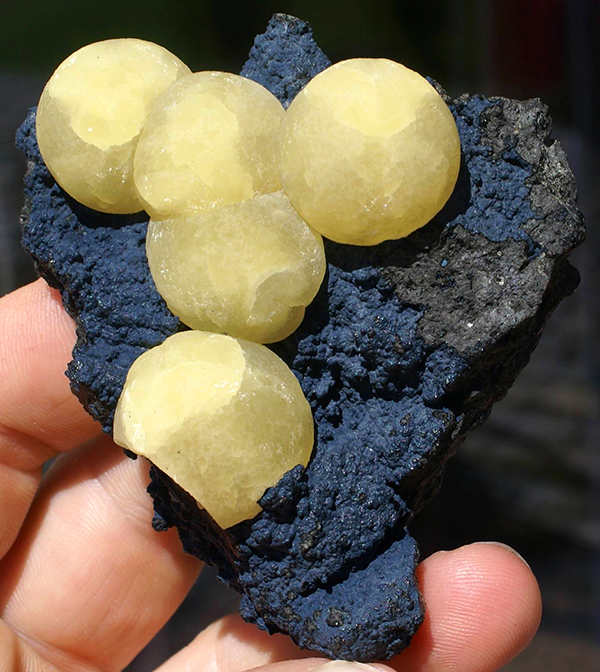
Very rarely specimens in that zone are found like this one - as loose small floaters. Calcite on bluish ferrosaponite. Size 6.5 cm. M. Oleszczuk specimen. T. Praszkier photo.

Rare, high quality specimen of constractive calcites on ferrosaponite. Size 10 cm. Spirifer collection. J. Callen photo.
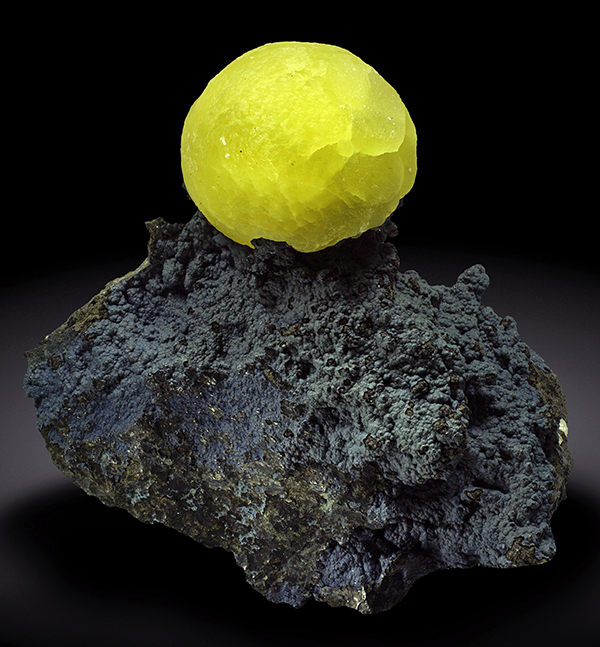
The only specimen of calcite "ball" perched on the top of basalt coated with ferrosaponite, complete all around. Size 5 cm. Spirifer collection. J. Callen photo.
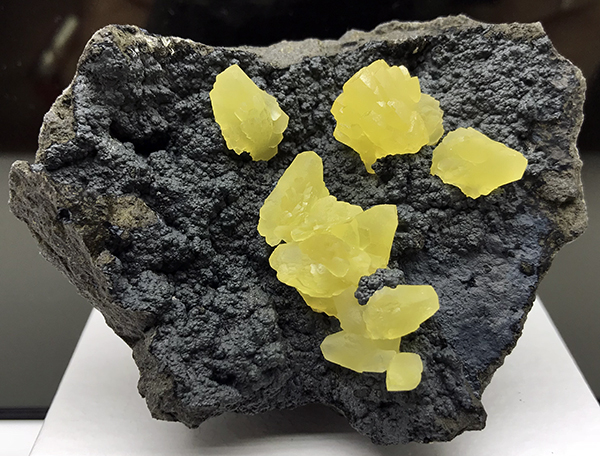
Yellow calcite crystals on ferrosaponite. Size 8.5 cm. Spirifer collection. J. Praszkier photo.
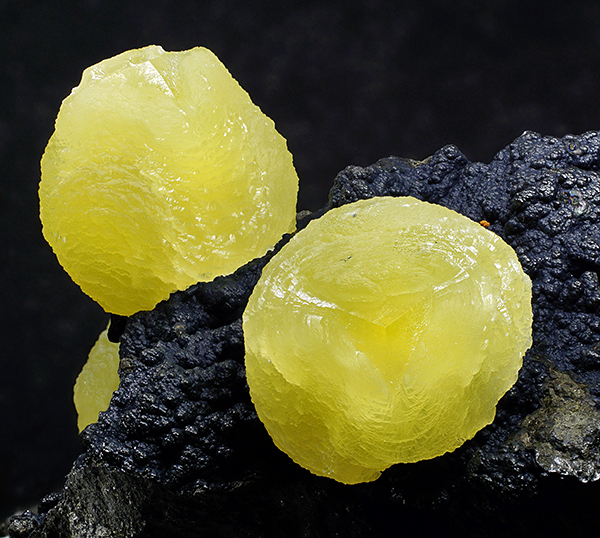
Complex calcite crystals on black ferrosaponite. Size of calcite aggregates 2.5 cm. Spirifer collection. J. Callen photo.
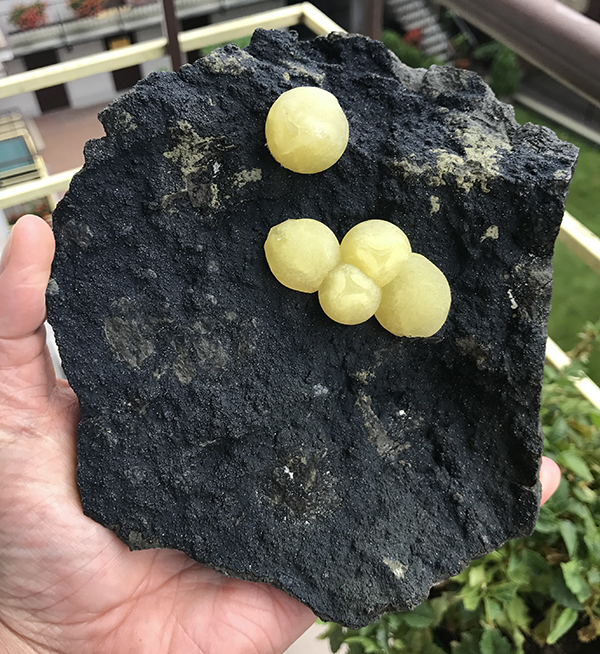
One of the best specimens found as far in the second productive zone. Size 17 cm. Spirifer collection. T. Praszkier photo.
MINERALS
Calcite is obviously the most important mineral species in Grabiszyce. Its general characteristics is very different in both zones described above.
Calcite from the breccia zone is very distinctive and always developed as a “carpet” of crystals coating walls of the cavities. They are formed as simple very steep rhombohedrons tightly packed and forming drusy clusters. Their size is usually between 2 and 5 mm. In some pockets crystals form “hedgehog” like sprays sprinkled on “normal” drusy calcites. The color varies from yellowish-grey, yellow to orange-reddish. The luster varies from poor to good.
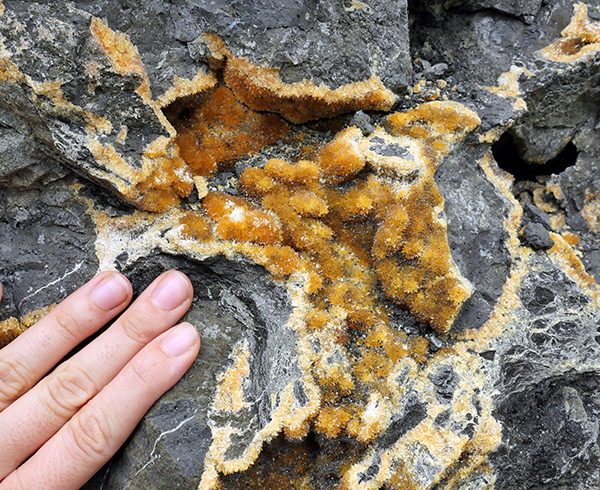
Typical pocket in the berccia zone with the walls coated with a "carpet" of orange calcite. J. Praszkier photo.
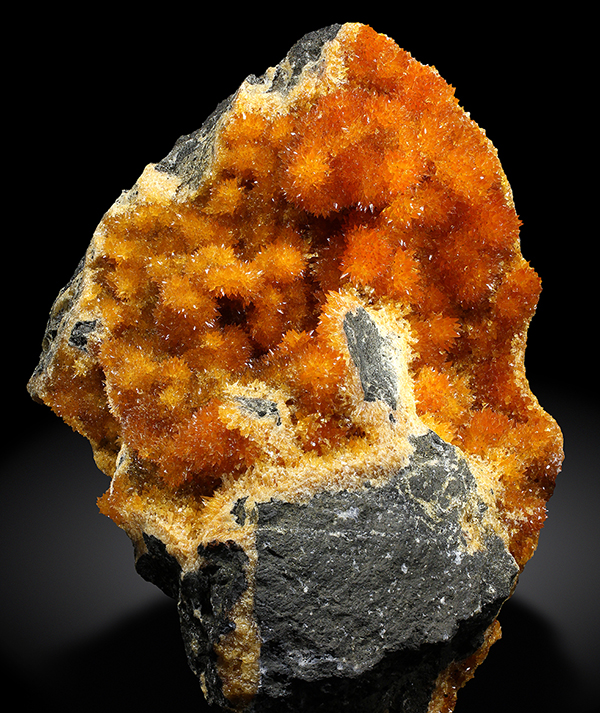
Fragment of the calcite pocket from breccia zone, coated with a "carpet" of the steep rhombohedral crystals. Size 17 cm. K. Tekiela collection. J. Callen photo.

Close up of the rosette of calcite rhombohedral crystals, typical for the breccia zone. Size of the rosette is 2 cm. J. Callen photo.
The morphology and crystallography of calcite in the zone located on the top of the main basalt flow is much more complex and diverse. Rhombohedra are the only crystallographic forms present, but in at least two different orders – a shallow one, and steep one. There is a complete lack of simple crystal forms such as simple rhombohedron, all of the calcites are complex aggregates of macromosaic rhombohedra. The most common aggregate habit is spheres, some of them look almost botryoidal. However, rather than being aggregates of radiating crystals they are aggregates of more or less curved rhombohedral crystals. Depending on type of rhombohedron and degree of curving different aggregate morphologies are formed. In most of the specimens well developed rhombohedron faces are “sticking out” from spheroidal part of the aggregate. A very distinctive feature of the “botryoidal like” aggregates is the presence of “Mercedes emblems”. These are traces of the rhobohedron terminations which are completely covered by extremely curved and bent peripheral parts of the aggregates.

Series of photos showing the continuity of calcite forms; all of them are complex aggregates of macromosaic rhombohedra with different morphologies depending on the degree of curving of rhombohedron edges - from those with rhombohedron faces well visible to the “botryoidal like” aggregates that look like spheres. FOV 7 cm. P. Lejczak collection. J. Praszkier photo.
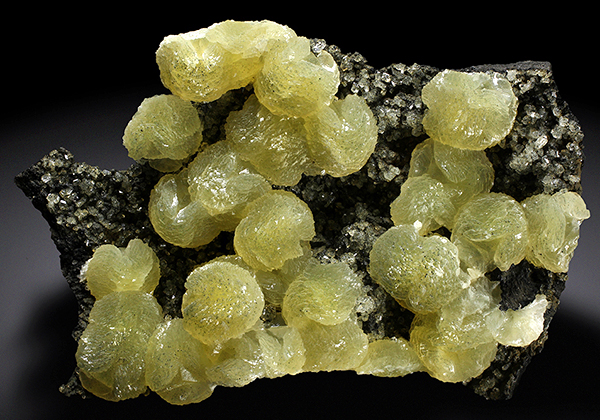
Series of photos showing the continuity of calcite forms; all of them are complex aggregates of macromosaic rhombohedra with different morphologies depending on the degree of curving of rhombohedron edges - from those with rhombohedron faces well visible to the “botryoidal like” aggregates that look like spheres. Size 11 cm. K. Tekiela collection. J. Callen photo.
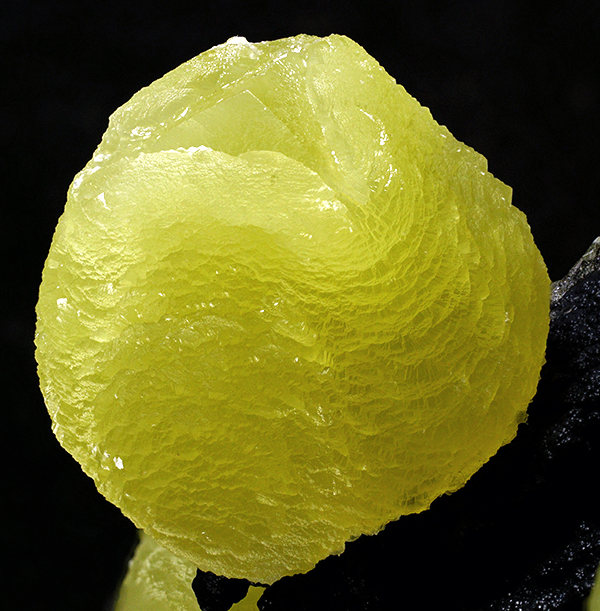
Series of photos showing the continuity of calcite forms; all of them are complex aggregates of macromosaic rhombohedra with different morphologies depending on the degree of curving of rhombohedron edges - from those with rhombohedron faces well visible to the “botryoidal like” aggregates that look like spheres."Ball" size 2.5 cm. Spirifer collection. J. Callen photo.
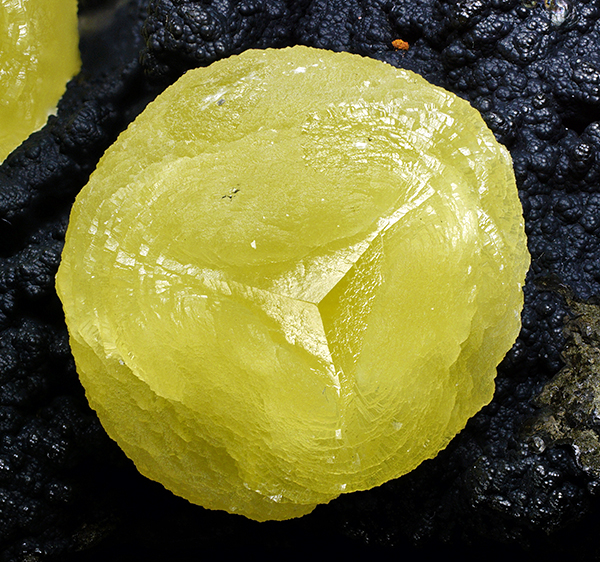
Series of photos showing the continuity of calcite forms; all of them are complex aggregates of macromosaic rhombohedra with different morphologies depending on the degree of curving of rhombohedron edges - from those with rhombohedron faces well visible to the “botryoidal like” aggregates that look like spheres. "Ball" size 2.5 cm. Spirifer collection. J. Callen photo.

Series of photos showing the continuity of calcite forms; all of them are complex aggregates of macromosaic rhombohedra with different morphologies depending on the degree of curving of rhombohedron edges - from those with rhombohedron faces well visible to the “botryoidal like” aggregates that look like spheres. Crystal size 2 cm. K. Tekiela collection. J. Callen photo.
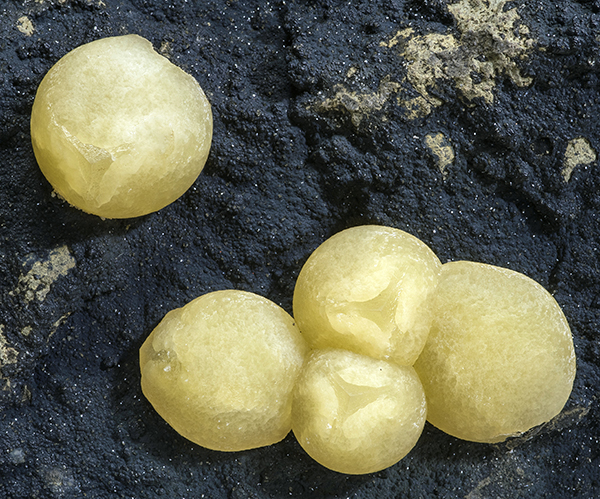
Series of photos showing the continuity of calcite forms; all of them are complex aggregates of macromosaic rhombohedra with different morphologies depending on the degree of curving of rhombohedron edges - from those with rhombohedron faces well visible to the “botryoidal like” aggregates that look like spheres. FOV 8 cm. Spirifer collection. J. Scovil photo.
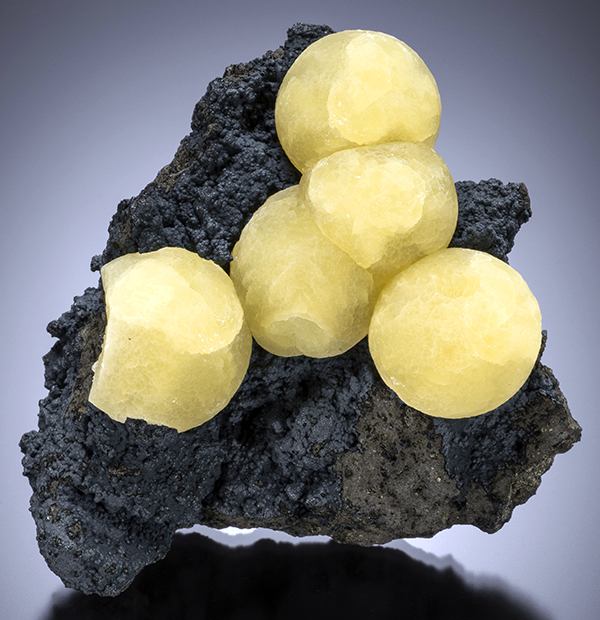
Series of photos showing the continuity of calcite forms; all of them are complex aggregates of macromosaic rhombohedra with different morphologies depending on the degree of curving of rhombohedron edges - from those with rhombohedron faces well visible to the “botryoidal like” aggregates that look like spheres. Size 6.3 cm. M. Oleszczuk collection. J. Scovil photo.

“Mercedes emblem” - distinctive feature of the “botryoidal like” aggregates. These are traces of the rhobohedron terminations which are completely covered by extremely curved and bent peripheral parts of the aggregates. Close-up of the previous photo.
In some cases, when the steeper rhombohedron is dominant form, sharply formed faces, which are “sticking out” from the sphere, are shifted and split forming even more complex aggregates. The diameter of the aggregates is usually from 1 to 3 cm. Color is always yellow but in various shades. The luster is usually satiny.

Complex calcite aggregates with splitted and shifted steep rhombohedron forms. FOV 6 cm. K. Tekiela collection. J. Callen photo.

Complex calcite aggregates with splitted and shifted steep rhombohedron forms. Size 9.5 cm. Spirifer collection. J. Scovi photo.
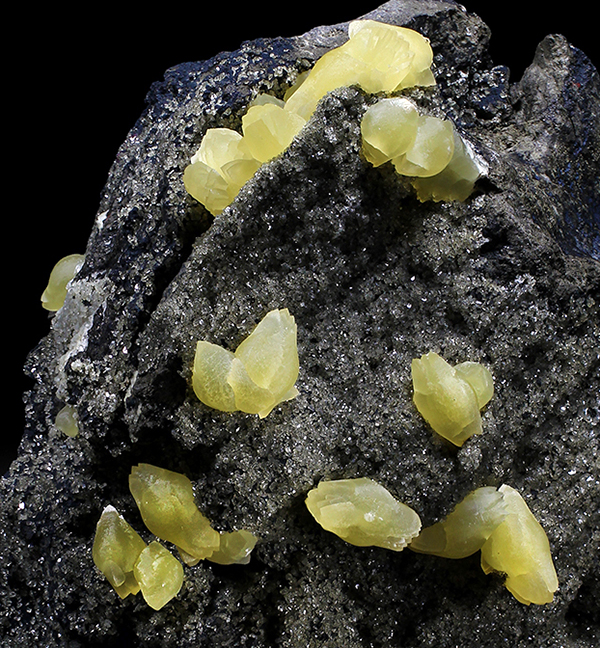
Complex calcite aggregates with spheroidal central part and splitted and shifted steep rhombohedal terminations on both ends. FOV 9 cm. K. Tekiela collection. J. Callen photo.
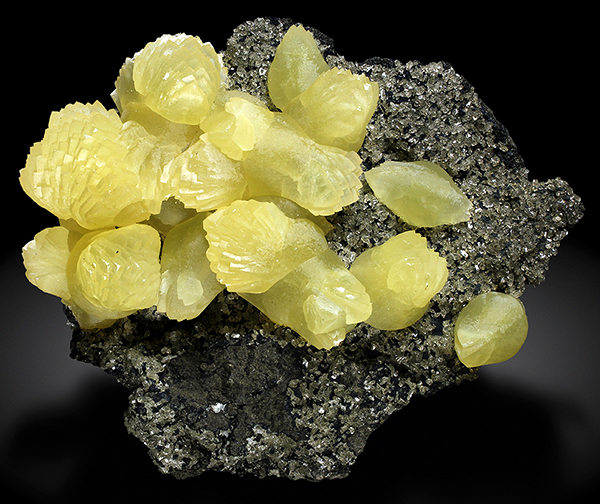
Complex calcite aggregates in "bow tie" forms featuring splitted and shifted steep rhombohedron forms. Size 6 cm. M. Oleszczuk collection. J. Callen photo.

Complex calcite aggregates in "bow tie" forms featuring splitted and shifted steep rhombohedron forms. Size 7 cm. Spirifer collection. J. Praszkier photo.
Ferrosaponite is a clay mineral, very rarely being part of the mineral specimens in general. In Grabiszyce it occurs in the zone on the top of the lava flow. It is developed as thin globular layer covering pockets walls. Color of the surface is usually black or grey, but in some pockets, can be blue or even iridescent with rainbow colors.
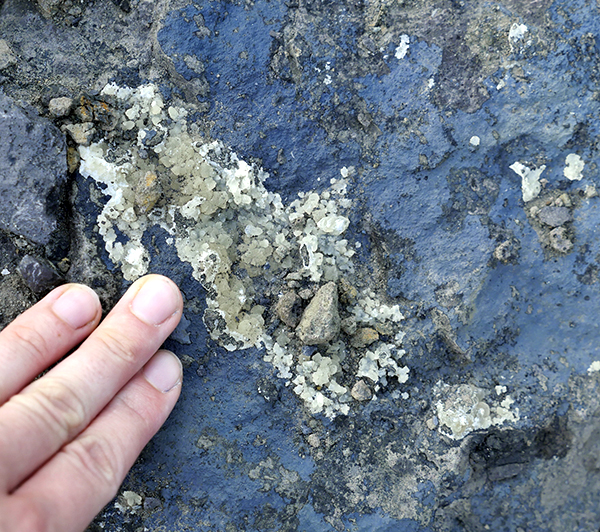
Coatings of the blue ferrosaponite around the calcite pocket, in situ. J. Praszkier photo.

Coatings of the bluish ferrosaponite with spheroidal calcites. J. Praszkier photo.

Globular iridescent ferrosaponite with spheroidal calcite, size 6 cm. Spirifer collection. J. Scovil photo.
Phillipsite is an accessory mineral occurring only in the zone on the top of the lava flow with spheroidal calcites. It is present in minority of the pockets, usually formed as 1-2 mm big crystals, always sharp with great luster. In some pockets crystals can reach up to 3-4 mm.
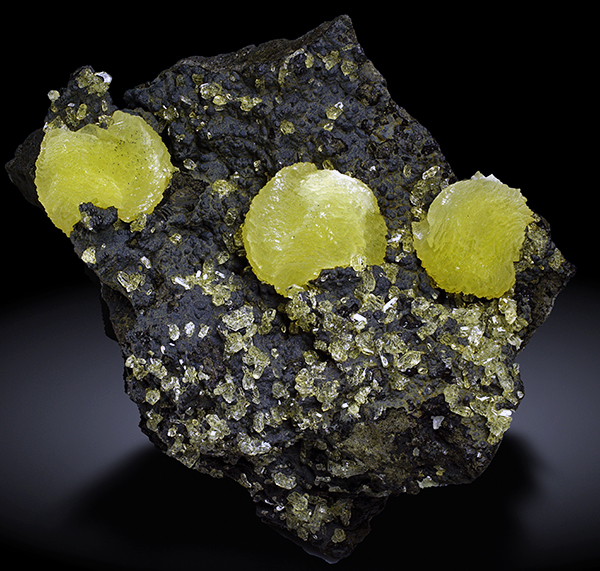
Gemmy and lustrous phillipsite crystals on black ferrosaponite with spheroidal calcite, size 7 cm. Spirifer collection. J. Callen photo.
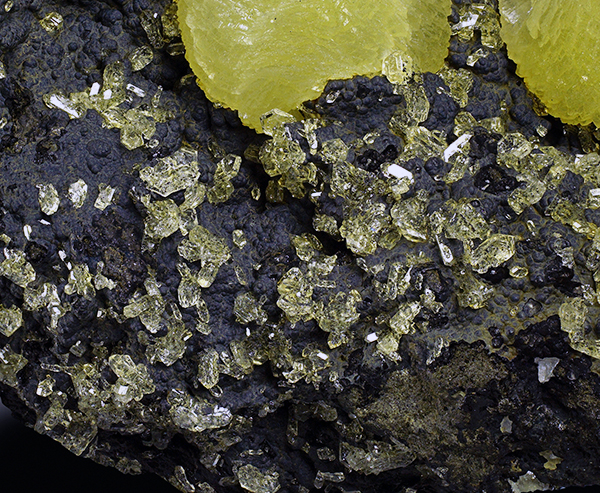
Close up of the phillipsite on the specimen pictured above, FOV about 3 cm. Spirifer collection. J. Callen photo.
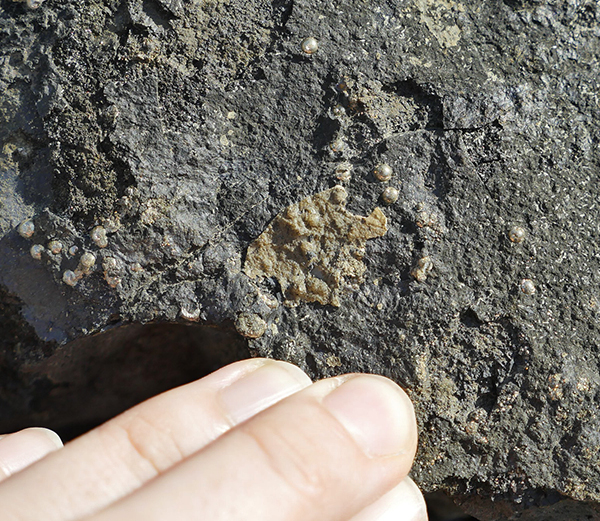
Pyrite spheroidal aggregates on basalt. J. Praszkier photo.
FUTURE PERSPECTIVES
Grabiszyce quarry has almost reached the limits of mining claim, and if expanding the claim will be possible is unknown at the moment. Brecciated zone with orange calcites is almost completely extracted, so the only remaining productive area is the zone on the top of the lava flow.
Acknowledgments
We would like to thank prof John Rakovan for his help with editing this article.
See specimens from Grabiszyce in our store
| Comments |
NEW ARTICLES
TRAVELS & ARTICLES
- Pyrite find in Finland
- Mineral notes: New zircons and pyrochlores from Morocco
- Mineral notes: New natrolites from Morocco
- Mineral pottery by Dr. Justyna Domańska-Siuda
- Calcites from Malaysia
- Veszelyites and other minerals from Congo
- Travelling through Arizona & New Mexico, USA
- Halites from the Solno Salt Mine, Poland
- Secondary minerals from Maramureș, Romania
- Calcites from Grabiszyce Quarry, Poland
OUR PUBLICATIONS
- "Fluorites from Taourirt, Morocco" in Mineralogical Almanach
- "Calcites from Grabiszyce, Poland" in LRM 2018
- "Baryte" article in the extraLapis
- MINERALS - The Collectors Newspaper #9
- MINERALS - The Collectors Newspaper #8
- Solno halites article in the Mineralogical Record
- MINERALS - The Collectors Newspaper #7
- MINERALS - The Collectors Newspaper #6
- Mibladen monograph in the Mineralogical Record
- African Secrets book